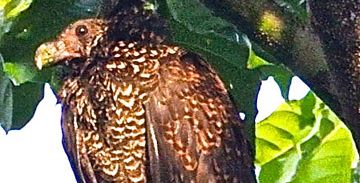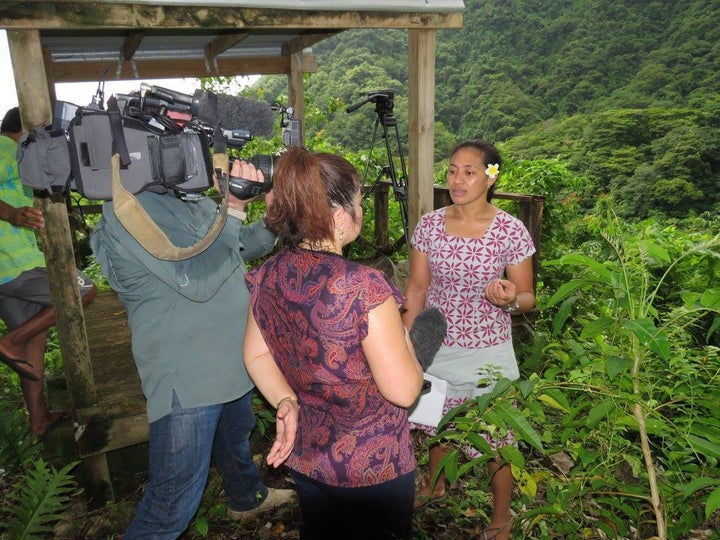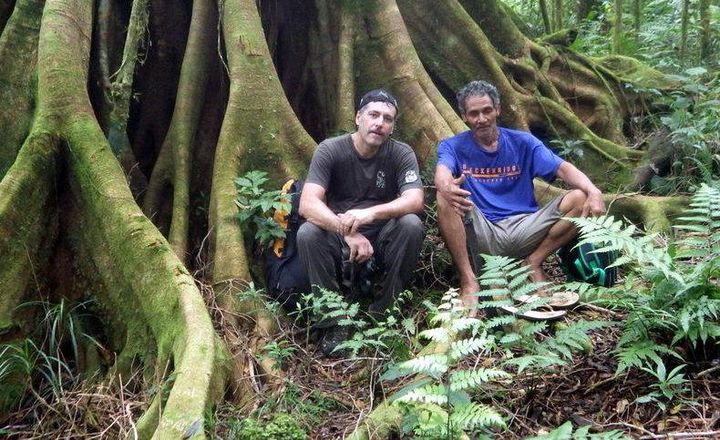
The last photo taken of a live manumea, sighted on the edges of the low land forest of the island of Savaii in 2012.
The already dwindling numbers of Samoas national bird, the manumea is now at a greater threat due to the impacts of climate change on their habitats. The manumea bird, which is endemic to Samoa, is feared to be near extinction as sightings become a rare occurrence in the forests of Samoa. Known as the tooth-billed pigeon (Didunculus strigirostris), it is listed as critically endangered on the International Union for the Conservation of Nature red list of globally threatened species.
Dr. Gianluca Serra, a Scientist who has spent years tracking the bird and working with the Government of Samoa and the Samoa Conservation Society on ways to manage the recovery of the manumea fears that climate change has added a greater challenge to saving the manumea. “Climate change impacts such as frequent cyclones has deleterious effect on the manumea through forest habitat degradation. Impacts such as temperature variation, prolonged droughts and high rainfall are also threats resulting from climate change. These impacts all affect the manumea, and as far as we are aware, it is not an ecologically very adaptable as a species,” Serra said.
According to the Scientist – the manumea may become extinct within years if Samoa is hit by more intense cyclones in that period. “Climate change is making the whole manumea conservation saga more urgent. We cannot do much to revert climate change at this stage, nor to adapt the manumea to it,” Serra said. “Without major cyclones it could become extinct in the course of 5-15 years, if not effective conservation action is taken.”
In the past five years Samoas Ministry of Natural Resources and Environment have worked closely with partners such as the Samoa Conservation Society with assistance from the Darwin Initiative and other international organizations have worked together to track the bird to ensure targeted management efforts.
“We have fresh information on where manumea still occur: thus we should focus on these forests and mitigate the threats of climate change to the bird. Each forest may have different priorities about the threats but in general they apply for most forests,” Serra said.

Moeumu Uili during an interview about the manumea.
The three main threats to the bird are suspected to be loss of forest habitats through cyclones and other natural disasters and human driven activities, invasive species and hunting. The situation is so dire for Samoa’s native species, that some scientists estimate the head count at less than 200.
The last photograph taken of the manumea was in 2012 by a conservationist for the Ministry of Natural Resources and Environment, Ms. Moeumu Uili. “Everyone had questioned whether the bird still existed. Now we know it is still alive,” she said, after having released the photograph.
During the 2012 rapid biodiversity assessment (BioRap Assessment) of the presumed stronghold in the forest of upper Savaii the bird was not sighted Hope was restored when one was sighted during the BioRap assessment in Uafato, Upolu last year. Dr Ulf Beichle, who studied the manumea in the 1970-80s and in the 1990s, estimated a larger number, over 2000 head count in the mid-1980s. But in the 1990s the population showed a drastic decline probably owing to the effects of cyclones such that, in 2000, fewer mature individuals were believed to survive. Several hunters from village of Samoa confirmed this view. Birdlife International noted that in 1999 and 2000, surveys on Savai’i showed that it had become rare with pairs scattered in suitable habitat.
During the most recent manumea survey of 2015-16 the bird was detected in 4 different forests of Upolu and Savaii but estimates of abundance cannot be made due to the “cryptic” behaviour of the bird, that hides very effectively in the rainforest canopy, and due to the recently realized problem of its call reliable identification.

Dr. Gianluca Serra during one of the manumea surveys, with Malaita Onolua, 55 years, hunter and tourist guide from Aopo, in Savaii. He killed one Manumea 12 years ago which he sincerely regrets.
According to Serra and other scientists, there are currently no clear elements to tell apart the call of Manumea from the call of the common and coexisting pigeon known as Lupe but through science and traditional knowledge it is estimated that the situation is critical with a few birds left in the order of the dozens.
The Government of Samoa is working with local and international partners on a management plan to assist in the recovery of Samoas native bird.
